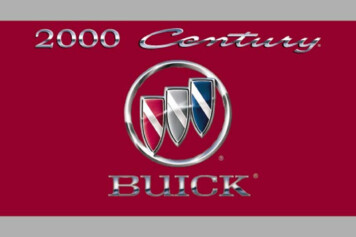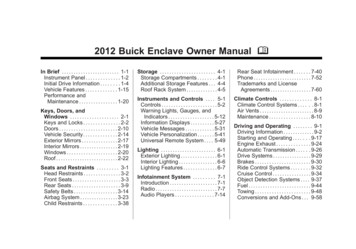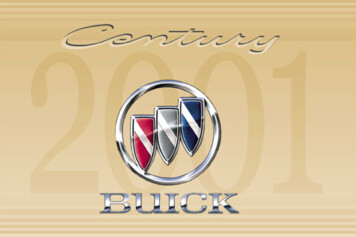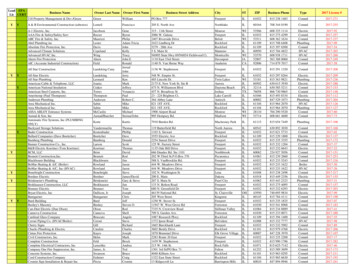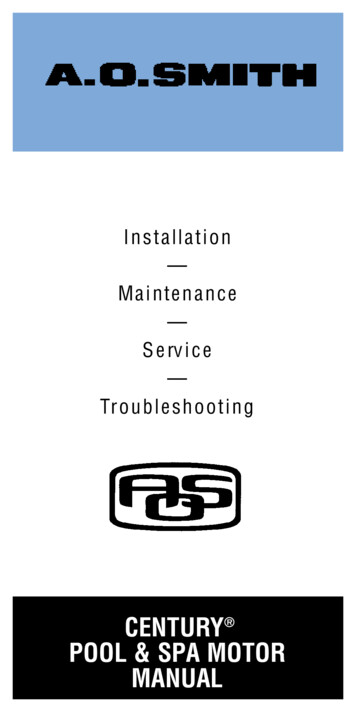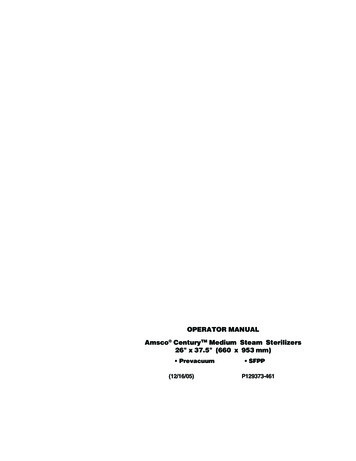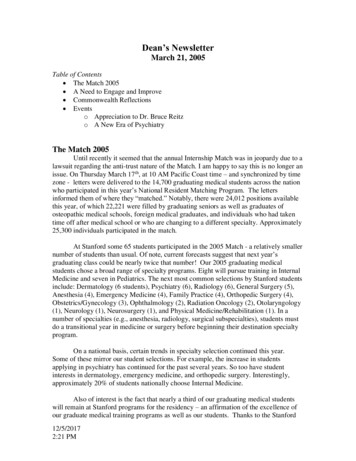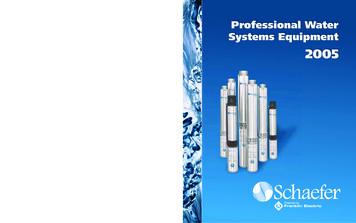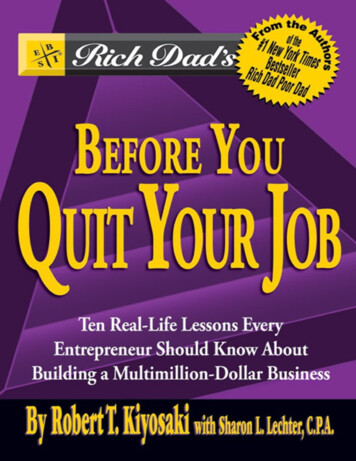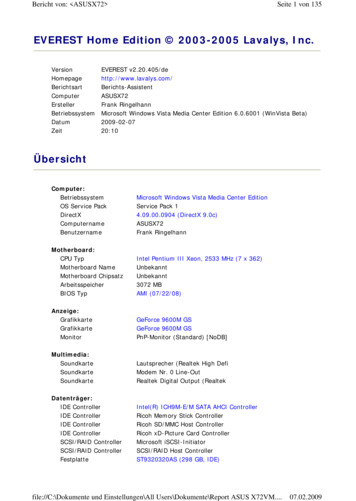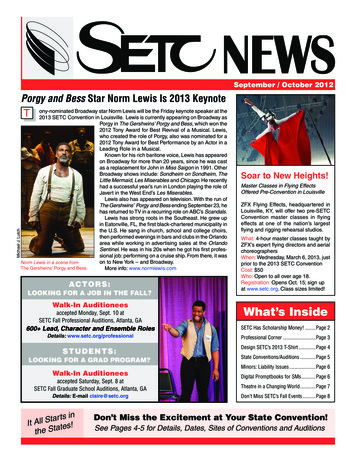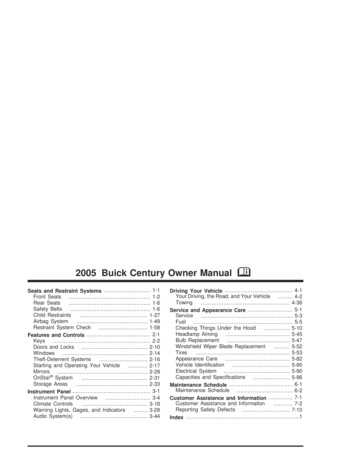
Transcription
2005 Buick Century Owner ManualSeats and Restraint Systems . 1-1Front Seats . 1-2Rear Seats. 1-6Safety Belts. 1-6Child Restraints. 1-27Airbag System. 1-49Restraint System Check. 1-58Features and Controls . 2-1Keys. 2-2Doors and Locks . 2-10Windows . 2-14Theft-Deterrent Systems . 2-16Starting and Operating Your Vehicle. 2-17Mirrors . 2-29OnStar System. 2-31Storage Areas. 2-33Instrument Panel . 3-1Instrument Panel Overview . 3-4Climate Controls. 3-18Warning Lights, Gages, and Indicators. 3-28Audio System(s) . 3-44MDriving Your Vehicle . 4-1Your Driving, the Road, and Your Vehicle. 4-2Towing. 4-36Service and Appearance Care . 5-1Service . 5-3Fuel . 5-5Checking Things Under the Hood. 5-10Headlamp Aiming . 5-45Bulb Replacement. 5-47Windshield Wiper Blade Replacement. 5-52Tires. 5-53Appearance Care. 5-82Vehicle Identification. 5-90Electrical System . 5-90Capacities and Specifications. 5-96.6-1Maintenance ScheduleMaintenance Schedule . 6-2Customer Assistance and Information . 7-1Customer Assistance and Information. 7-2Reporting Safety Defects . 7-10Index .1
Canadian OwnersA French language copy of this manual can be obtainedfrom your dealer or from:Helm, IncorporatedP.O. Box 07130Detroit, MI 48207GENERAL MOTORS, GM, the GM Emblem, BUICK,the BUICK Emblem, and the name CENTURY areregistered trademarks of General Motors Corporation.This manual includes the latest information at the time itwas printed. We reserve the right to make changes inthe product after that time without notice. For vehiclesfirst sold in Canada, substitute the name “GeneralMotors of Canada Limited” for Buick Motor Divisionwhenever it appears in this manual.Keep this manual in your vehicle, so it will be there ifyou ever need it while you are on the road. If yousell the vehicle, leave this manual in the vehicle.Litho in U.S.A.Part No. 05CENTURY A First EditioniiHow to Use This ManualMany people read the owner manual from beginning toend when they first receive their new vehicle. If thisis done, it can help you learn about the featuresand controls for the vehicle. Pictures and words worktogether in the owner manual to explain things.IndexA good place to quickly locate information about thevehicle is the Index in the back of the manual. It isan alphabetical list of what is in the manual andthe page number where it can be found. Copyright General Motors Corporation 3/22/04All Rights Reserved
Safety Warnings and SymbolsThere are a number of safety cautions in this book.We use a box and the word CAUTION to tell aboutthings that could hurt you if you were to ignorethe warning.You will also find a circlewith a slash through it inthis book. This safetysymbol means “Do Not,”“Do Not do this” or “Do Notlet this happen.”{CAUTION:These mean there is something that could hurtyou or other people.In the caution area, we tell you what the hazard is.Then we tell you what to do to help avoid or reducethe hazard. Please read these cautions. If you do not,you or others could be hurt.iii
Vehicle Damage WarningsVehicle SymbolsAlso, in this manual you will find these notices:The vehicle has components and labels that usesymbols instead of text. Symbols are shown along withthe text describing the operation or informationrelating to a specific component, control, message,gage, or indicator.Notice: These mean there is something that coulddamage your vehicle.A notice tells about something that can damage thevehicle. Many times, this damage would not be coveredby your vehicle’s warranty, and it could be costly. Butthe notice will tell what to do to help avoid the damage.When you read other manuals, you might seeCAUTION and NOTICE warnings in different colorsor in different words.There are also warning labels on the vehicle. They usethe same words, CAUTION or NOTICE.ivIf you need help figuring out a specific name of acomponent, gage, or indicator, reference thefollowing topics: Seats and Restraint Systems in Section 1Features and Controls in Section 2Instrument Panel Overview in Section 3Climate Controls in Section 3Warning Lights, Gages, and Indicators in Section 3Audio System(s) in Section 3Engine Compartment Overview in Section 5
These are some examples of symbols that may be found on the vehicle:v
NOTESvi
Section 1Seats and Restraint SystemsFront Seats .1-2Manual Seats .1-2Power Seat .1-3Reclining Seatbacks .1-4Head Restraints .1-5Rear Seats .1-6Split Folding Rear Seat .1-6Safety Belts .1-6Safety Belts: They Are for Everyone .1-6Questions and Answers About Safety Belts .1-11How to Wear Safety Belts Properly .1-12Driver Position .1-12Shoulder Belt Height Adjustment .1-18Safety Belt Use During Pregnancy .1-19Right Front Passenger Position .1-19Center Passenger Position .1-20Rear Seat Passengers .1-21Rear Safety Belt Comfort Guides forChildren and Small Adults .1-24Safety Belt Extender .1-26Child Restraints .1-27Older Children .1-27Infants and Young Children .1-30Child Restraint Systems .1-33Where to Put the Restraint .1-36Top Strap .1-37Top Strap Anchor Location .1-39Lower Anchorages and Top Tethers forChildren (LATCH System) .1-40Securing a Child Restraint Designed forthe LATCH System .1-42Securing a Child Restraint in aRear Outside Seat Position .1-42Securing a Child Restraint in a CenterRear Seat Position .1-44Securing a Child Restraint in the RightFront Seat Position .1-46Airbag System .1-49Where Are the Airbags? .1-52When Should an Airbag Inflate? .1-54What Makes an Airbag Inflate? .1-55How Does an Airbag Restrain? .1-55What Will You See After anAirbag Inflates? .1-56Servicing Your Airbag-Equipped Vehicle .1-58Restraint System Check .1-58Checking Your Restraint Systems .1-58Replacing Restraint System PartsAfter a Crash .1-591-1
Front SeatsManual Seats{CAUTION:You can lose control of the vehicle if you try toadjust a manual driver’s seat while the vehicleis moving. The sudden movement could startleand confuse you, or make you push a pedalwhen you do not want to. Adjust the driver’sseat only when the vehicle is not moving.1-2Lift the bar located under the front of the passenger’sseat to unlock the seat. Slide the seat to the desiredposition and release the bar. Try to move the seat tobe sure it is locked into place.
Power SeatTo adjust the power seat, do the following: To move the seat forward or rearward, push thecontrol forward or rearward. To raise or lower the entire seat, push the controlup or down. To raise or lower the front of the seat, push thefront of the control up or down. To raise or lower the rear of the seat, push the rearof the control up or down.If your vehicle has this feature, the power seat control islocated on the outboard side of the driver’s seat cushion.1-3
Reclining SeatbacksTo adjust the seatback, lift the lever located on theoutboard side of the seat and move the seatbackto where you want it. Release the lever to lock theseatback. Pull up on the lever without pushing on theseatback and the seatback will go to an upright position.1-4But don’t have a seatback reclined if your vehicleis moving.
Head Restraints{CAUTION:Sitting in a reclined position when your vehicleis in motion can be dangerous. Even if youbuckle up, your safety belts can not do theirjob when you are reclined like this.The shoulder belt can not do its job because itwill not be against your body. Instead, it will bein front of you. In a crash you could go into it,receiving neck or other injuries.The lap belt can not do its job either. In acrash the belt could go up over your abdomen.The belt forces would be there, not at yourpelvic bones. This could cause seriousinternal injuries.For proper protection when the vehicle is inmotion, have the seatback upright. Then sitwell back in the seat and wear your safetybelt properly.Adjust your head restraint so that the top of the restraintis closest to the top of your head. This positionreduces the chances of a neck injury in a crash.1-5
Rear SeatsSafety BeltsSplit Folding Rear SeatSafety Belts: They Are for EveryoneIf the vehicle has a split folding seat, you can gainaccess to the interior of the vehicle through the trunk.This part of the manual tells you how to use safetybelts properly. It also tells you some things you shouldnot do with safety belts.To do this, pull forwardon the seat tab, locatedon the side of therear seat, to move therear seatback down.To return the seatback to its original position, push itback up, making sure the seat latch locks it in place.1-6{CAUTION:Do not let anyone ride where he or she can notwear a safety belt properly. If you are in acrash and you are not wearing a safety belt,your injuries can be much worse. You can hitthings inside the vehicle or be ejected from it.You can be seriously injured or killed. In thesame crash, you might not be, if you arebuckled up. Always fasten your safety belt,and check that your passengers’ belts arefastened properly too.
In most states and in all Canadian provinces, the lawsays to wear safety belts. Here is why: They work.{CAUTION:You never know if you will be in a crash. If you do havea crash, you do not know if it will be a bad one.It is extremely dangerous to ride in a cargoarea, inside or outside of a vehicle. In acollision, people riding in these areas are morelikely to be seriously injured or killed. Do notallow people to ride in any area of your vehiclethat is not equipped with seats and safetybelts. Be sure everyone in your vehicle is in aseat and using a safety belt properly.A few crashes are mild, and some crashes can be soserious that even buckled up, a person would notsurvive. But most crashes are in between. In many ofthem, people who buckle up can survive and sometimeswalk away. Without belts they could have been badlyhurt or killed.After more than 30 years of safety belts in vehicles,the facts are clear. In most crashes buckling updoes matter.a lot!Your vehicle has a lightthat comes on as areminder to buckle up.See Safety Belt ReminderLight on page 3-30.1-7
Why Safety Belts WorkWhen you ride in or on anything, you go as fast asit goes.Put someone on it.Take the simplest vehicle. Suppose it is just a seaton wheels.1-8
Get it up to speed. Then stop the vehicle. The riderdoes not stop.The person keeps going until stopped by something.In a real vehicle, it could be the windshield.1-9
or the instrument panel.or the safety belts!With safety belts, you slow down as the vehicle does.You get more time to stop. You stop over more distance,and your strongest bones take the forces. That is whysafety belts make such good sense.1-10
Questions and Answers AboutSafety BeltsQ: Will I be trapped in the vehicle after an accidentif I am wearing a safety belt?A: You could be – whether you are wearing a safetybelt or not. But you can unbuckle a safety belt,even if you are upside down. And your chance ofbeing conscious during and after an accident,so you can unbuckle and get out, is much greaterif you are belted.Q: If I am a good driver, and I never drive far fromhome, why should I wear safety belts?A: You may be an excellent driver, but if you are in anaccident – even one that is not your fault – you andyour passengers can be hurt. Being a gooddriver does not protect you from things beyond yourcontrol, such as bad drivers.Most accidents occur within 25 miles (40 km) ofhome. And the greatest number of serious injuriesand deaths occur at speeds of less than 40 mph(65 km/h).Safety belts are for everyone.Q: If my vehicle has airbags, why should I have towear safety belts?A: Airbags are in many vehicles today and will bein most of them in the future. But they aresupplemental systems only; so they work withsafety belts – not instead of them. Every airbagsystem ever offered for sale has required the use ofsafety belts. Even if you are in a vehicle that hasairbags, you still have to buckle up to get the mostprotection. That is true not only in frontal collisions,but especially in side and other collisions.1-11
How to Wear Safety Belts ProperlyThis part is only for people of adult size.Be aware that there are special things to know aboutsafety belts and children. And there are differentrules for smaller children and babies. If a child will beriding in your vehicle, see Older Children on page 1-27or Infants and Young Children on page 1-30. Followthose rules for everyone’s protection.First, you will want to know which restraint systems yourvehicle has.We will start with the driver position.Driver PositionThis part describes the driver’s restraint system.Lap-Shoulder BeltThe driver has a lap-shoulder belt. Here is how towear it properly.1. Close and lock the door.2. Adjust the seat so you can sit up straight.To see how, see “Seats” in the Index.1-123. Pick up the latch plate and pull the belt across you.Do not let it get twisted.The shoulder belt may lock if you pull the beltacross you very quickly. If this happens, let the beltgo back slightly to unlock it. Then pull the beltacross you more slowly.
4. Push the latch plate into the buckle until it clicks.Pull up on the latch plate to make sure it is secure.If the belt is not long enough, see Safety BeltExtender on page 1-26.Make sure the release button on the buckle ispositioned so you would be able to unbuckle thesafety belt quickly if you ever had to.The lap part of the belt should be worn low and snug onthe hips, just touching the thighs. In a crash, this appliesforce to the strong pelvic bones. And you would be lesslikely to slide under the lap belt. If you slid under it, thebelt would apply force at your abdomen. This could causeserious or even fatal injuries. The shoulder belt should goover the shoulder and across the chest. These parts ofthe body are best able to take belt restraining forces.5. To make the lap part tight, pull down on the buckleend of the belt as you pull up on the shoulder belt.The safety belt locks if there is a sudden stop or crash,or if you pull the belt very quickly out of the retractor.1-13
Q: What is wrong with this?{CAUTION:You can be seriously hurt if your shoulder beltis too loose. In a crash, you would moveforward too much, which could increase injury.The shoulder belt should fit against your body.A: The shoulder belt is too loose. It will not give nearlyas much protection this way.1-14
Q: What is wrong with this?{CAUTION:You can be seriously injured if your belt isbuckled in the wrong place like this. In a crash,the belt would go up over your abdomen.The belt forces would be there, not at thepelvic bones. This could cause serious internalinjuries. Always buckle your belt into thebuckle nearest you.A: The belt is buckled in the wrong place.1-15
Q: What is wrong with this?{CAUTION:You can be seriously injured if you wear theshoulder belt under your arm. In a crash, yourbody would move too far forward, which wouldincrease the chance of head and neck injury.Also, the belt would apply too much force tothe ribs, which are not as strong as shoulderbones. You could also severely injure internalorgans like your liver or spleen.A: The shoulder belt is worn under the arm. It shouldbe worn over the shoulder at all times.1-16
Q: What is wrong with this?{CAUTION:You can be seriously injured by a twisted belt.In a crash, you would not have the full widthof the belt to spread impact forces. If a beltis twisted, make it straight so it can workproperly, or ask your dealer to fix it.A: The belt is twisted across the body.1-17
Shoulder Belt Height AdjustmentBefore you begin to drive, move the shoulder beltadjuster to the height that is right for you.Adjust the height so that the shoulder portion of the belt iscentered on your shoulder. The belt should be away fromyour face and neck, but not falling off your shoulder.To unlatch the belt, just push the button on the buckle.The belt should go back out of the way.Before you close the door, be sure the belt is out ofthe way. If you slam the door on it, you can damageboth the belt and your vehicle.To move it down, squeeze the release lever and theshoulder belt guide as shown and move the heightadjuster to the desired position. You can move theadjuster up just by pushing up on the shoulder belt guide.1-18
After you move the adjuster to where you want it, try tomove it down without squeezing the release lever tomake sure it has locked into position.Safety Belt Use During PregnancySafety belts work for everyone, including pregnantwomen. Like all occupants, they are more likely to beseriously injured if they do not wear safety belts.A pregnant woman should wear a lap-shoulder belt,and the lap portion should be worn as low as possible,below the rounding, throughout the pregnancy.The best way to protect the fetus is to protect themother. When a safety belt is worn properly, it is morelikely that the fetus will not be hurt in a crash. Forpregnant women, as for anyone, the key to makingsafety belts effective is wearing them properly.Right Front Passenger PositionTo learn how to wear the right front passenger’s safetybelt properly, see Driver Position on page 1-12.The right front passenger’s safety belt works the sameway as the driver’s safety belt — except for one thing.If you ever pull the shoulder portion of the belt out all theway, you will en
Vehicle Damage Warnings Also, in this manual you will find these notices: Notice: These mean there is something that could damage your vehicle. A notice tells about something that can damage the vehicle. Many times, this damage would not be covered by your vehicle’s warranty, and it could be costly. But
